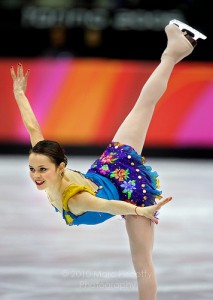
Photo used under Creative Commons License
Celeste Forrest, Staff Writer
I remember when I was seven years old, I participated in the 2002 Winter Olympics as a World Champion figure skater.
All right, in all honesty, I never participated in the Salt Lake City 2002 Olympics as a figure skater, nor was I ever an olympic champion at age seven, but for what it is worth, I did participate in my second grade class’ “Winter Olympics” in Denver, Colorado. It was great fun, pretending to “skate” around on my classroom’s carpet and jump and spin around like the figure skaters did on TV.
I remember being mesmerized by the figure skaters, twirling around and sparkling like jewels in their glitzy, colorful costumes. I admired them so much, specifically legendary skater, Michelle Kwan. During my little “skating performance” in front of my second grade class, I tried to imitate Michelle’s grace as best as a seven-year-old could. By the end of our class “Olympics,” my teacher awarded me with a pretend gold medal. “Well, if that’s all there is to it, this figure skating stuff is pretty easy,” I remember thinking.
But by the time I was old enough to understand the Olympics and the Olympic sport of figure skating, I learned that it is not just “easy stuff.”
In the eyes of an observer, figure skating looks like an artform. To put it simply, it is ballet on ice and seems more like a dance than a sport. You have the pretty, flowing costumes, lots of dazzle, fancy jumps and graceful hand motions. Figure skating is about beautiful young ladies showing up, putting on a performance in front of an audience and being scored on how much they impress the judges. The more extravagant the spectacle, the better.
This is what I first thought about figure skating years ago. However, two Winter Olympics and lots of research later, I have come to appreciate figure skating for the beautiful and technical sport that it is.
People would be pretty surprised to know how old figure skating is. Figure Skating was contested by the International Olympic Committee (IOC) in 1908 and has been a main part of the winter Olympics ever since, making the Olympic sport more than 100 years old. How does the IOC decide if a sport should become an Olympic event? According to their website, the IOC states that an event must fulfill numerous prerequisites in order to qualify as an Olympic sport.
In fact, an event is required to meet over 30 criteria for it to be considered. For example, the sport must be practiced by men in at least seventy-five countries and four continents and by women in at least forty countries and three continents. According to the 2008 Olympic Programme Commission, a sport must emphasize the development of youth, as be popular among spectators and media.
The sport of figure skating is by no means for the faint of heart. It requires years of building endurance, balance, flexibility and tenacity. Figure skating strains both the upper and lower body and requires lots of strength. Skaters must be physically fit, active and healthy if they are to compete. Many athletes who skate partake in a variety of other activities, such as weight-lifting, running, gymnastics and ballet.
Skaters, with years of training, patience and determination, are able to withstand dangerous falls with no padding and launch themselves three to four feet into the air, completing four rotations and land light on their feet, despite feeling the pressure of five to eight times their body’s weight. So much for easy stuff.
Figure skating, though artistic in form, is more than just a beautiful dance on ice. It is a science that requires strategy and technique and is one of the toughest sports to pursue. It is because of this that I highly admire and respect figure skating as an incredible, complex and powerfully inspiring sport.